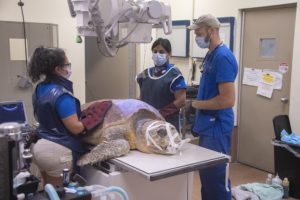|
Getting your Trinity Audio player ready...
|

While Zoo Miami prepares for the official ribbon-cutting ceremony for its new Sea Turtle Hospital scheduled for July 6, a huge female loggerhead sea turtle that was likely injured by a shark, has necessitated emergency care to help save the life of this threatened species.
On Sunday, May 22, Zoo Miami received a call from the Florida Fish and Wildlife Conservation Commission (FWC) that a large female loggerhead turtle had been rescued from the Port St. Lucie Power Plant with a severe wound to its left front flipper, leaving only exposed bone and torn flesh, the apparent victim of a shark attack.
Because Zoo Miami’s newly constructed Sea Turtle Hospital had recently passed inspection and received its permits to accept sick and injured sea turtles, it was decided to transfer the injured animal to the zoo for treatment and rehabilitation.
Upon arrival, the massive reptile weighed 388 pounds and was missing most of her left front flipper except for the exposed humerus bone. The turtle also had scars on its shell that indicated it had possibly been struck by a boat and bitten by another shark earlier in its life. In addition, after a close examination that included ultrasound, it was discovered that she was laden with eggs.
The Animal Health staff immediately stabilized the turtle in one of several special tanks designed to house sea turtles during treatment and rehabilitation to prepare them for release back to the wild. Once stabilized, she was given fluids as well as vitamins and food that included squid and crab.
On Monday the turtle was carefully transported from the recovery tank to a special pen that was filled with sand in hopes that she would be encouraged to deposit her eggs so that they could possibly be salvaged. In order to assist in this endeavor, she was given calcium and oxytocin to help stimulate her egg-laying.
By Tuesday morning, she had deposited over 100 eggs which were carefully collected so that they could be transported by the Miami-Dade Parks Sea Turtle Conservation Program staff with the approval of FWC and inserted into a man-made nest for incubation. Though some eggs were initially deposited in water and unlikely to hatch, there is hope that some of the eggs are fertile and will successfully hatch.
Following exams which included blood collection, X-Rays and an ultrasound exam, the turtle, named “Baymax,” was prepared for surgery. The ultrasound exam revealed that she still had dozens of eggs within her and some of them emerged during the procedure. They were carefully placed in a bin of sand to be transported like the others.
The main purpose of the surgery was to remove the exposed damaged bone and treat the amputated limb in a way that would help prevent infection and provide the approximately 50-year-old reptile with a more stable path towards healing. It is not uncommon for sea turtles to lose a limb to sharks or boat strikes. However, many adjust and continue to lead productive lives after losing the limb as long as they don’t succumb to blood loss or infection. That is the hope for this particular individual.
The entire procedure took several hours and was led by Zoo Miami Associate Veterinarian, Dr. Marisa Bezjian and assisted by Zoo Miami Chief Veterinarian, Dr. Gwen Myers. The exposed bone was removed successfully and the surrounding wound cleaned and treated.
After recovering in a special stall in the zoo’s main hospital, she was to be transferred back to her tank at the Sea Turtle Hospital where she will be closely monitored for several weeks until the staff feel that she is healthy enough to be returned to the wild.





